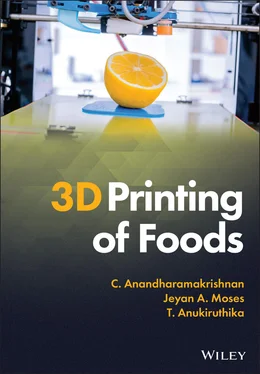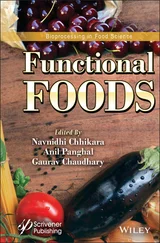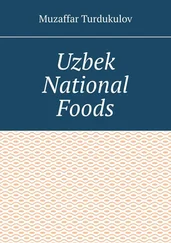C. Anandharamakrishnan - 3D Printing of Foods
Здесь есть возможность читать онлайн «C. Anandharamakrishnan - 3D Printing of Foods» — ознакомительный отрывок электронной книги совершенно бесплатно, а после прочтения отрывка купить полную версию. В некоторых случаях можно слушать аудио, скачать через торрент в формате fb2 и присутствует краткое содержание. Жанр: unrecognised, на английском языке. Описание произведения, (предисловие) а так же отзывы посетителей доступны на портале библиотеки ЛибКат.
- Название:3D Printing of Foods
- Автор:
- Жанр:
- Год:неизвестен
- ISBN:нет данных
- Рейтинг книги:3 / 5. Голосов: 1
-
Избранное:Добавить в избранное
- Отзывы:
-
Ваша оценка:
- 60
- 1
- 2
- 3
- 4
- 5
3D Printing of Foods: краткое содержание, описание и аннотация
Предлагаем к чтению аннотацию, описание, краткое содержание или предисловие (зависит от того, что написал сам автор книги «3D Printing of Foods»). Если вы не нашли необходимую информацию о книге — напишите в комментариях, мы постараемся отыскать её.
Explore the fascinating realm of 3D food printing and its applications 3D Printing of Foods
3D Printing of Foods
3D Printing of Foods
3D Printing of Foods — читать онлайн ознакомительный отрывок
Ниже представлен текст книги, разбитый по страницам. Система сохранения места последней прочитанной страницы, позволяет с удобством читать онлайн бесплатно книгу «3D Printing of Foods», без необходимости каждый раз заново искать на чём Вы остановились. Поставьте закладку, и сможете в любой момент перейти на страницу, на которой закончили чтение.
Интервал:
Закладка:
In view of sustainability, 3D printing allows for usage of lesser material resources with minimal material wastage. Further, 3D printing allows for the utilization of by‐products and waste streams of food industries such as fruits and vegetable peels, meat trimmings, and so on for the development of value‐added 3D printed foods. 3D food printing possesses both economic and environmental benefits that reduce the carbon footprints and overall product life cycle. As the need of the hour, the rising demand for the food shortage and animal protein demand can be encountered using 3D printing by adopting bioprinting principles in developing in‐vitro cultured artificial meats and meat analogues. Forecasting the future scale‐up operations, currently, 3D printing suffers from the limitation of lower print speed and less production rate. This can be overcome by adopting multi‐head printing systems. However, the extent of the feasibility of the adaption of multi‐heads to different food printing technologies remains under question. The use of multiple heads gradually complicates the coordination mechanism of movement arms and the integration of 3D printers with the microprocessor controlling unit. Hence, more research works on design components, accessories, software integration, and development are essential to bridge up the gap in reducing the difficulty involved with multi‐head print systems. Insights on design attributes would be useful for scaling up of process at an industrial level that results in higher operation speed and production rate. These features could gradually reduce the cost of operation as well as the price incurred with 3D printed foods.
With advancements in technology, 3D printing has a greater degrees of freedom that can be integrated with other food processing technologies. For instance, technologies such as encapsulation are well known for delivering functional foods. Similar approaches are adapted for the fabrication of functional 3D printed foods by encapsulating essential vitamins and minerals, probiotics, antioxidants, and so on. The basic coaxial‐based extrusion technique available for dual material printing can be modified to integrate 3D printing and encapsulation. 3D printing could be a promising solution for addressing malnourishment. The development in biotechnology paves a way for the analysis of genetic data through the use of ‘omics’ technology. This concept of retrieving individual genomic data for addressing health disorders can be improved efficiently by integrating with 3D food printing (Kumar et al. 2020). Hence, 3D printing has a far way to go that has the capability to revolutionize the nutraceuticals and food industry. More research works must be carried out in these directions for exploring the potential opportunities that exist with 3D printing. Not surprisingly, 3D printers could become a part of domestic kitchen appliance in the near future that transforms dietary practices.
2.10 Conclusion
3D printing is an additive technology when applied to foods aids in the customization and personalization of diets. Various printing technologies used for food printing are extrusion‐based techniques, sintering process, ink‐jet printing, binder jetting, and bioprinting. The basic difference exists with the mechanism of binding of the printed layers. Various system components, working principles, and factors affecting each of the printing technologies have been discussed in the present chapter. Apart from aesthetic benefits, 3D printing of foods seems to be environmentally friendly providing several economic benefits. The printability of food material can be determined by material properties and process variables. Advancements in 3D printing can take the existing technology to a next level in the delivery of functional foods thereby reduces the incidence of malnourishment. As a smart manufacturing process, 3D printing has been considered to be a part of 4.0 industrial revolution. In this regard, 3D printing is forecasted to be adaptable in the food sector in the development of novel and sustainable foods.
References
1 3D Systems (2013). Technology brings edible printing to professionals and consumers alike. https://www.3dsystems.com/press‐releases/3d‐systems‐acquires‐sugar‐lab(accessed 24 december 2019).
2 Alexander, P., Brown, C., Arneth, A. et al. (2017). Could consumption of insects, cultured meat or imitation meat reduce global agricultural land use? Global Food Security 15: 22–32.
3 Alomari, M., Mohamed, F.H., Basit, A.W., and Gaisford, S. (2015). Personalised dosing: printing a dose of one’s own medicine. International Journal of Pharmaceutics 494 (2): 568–577.
4 Amorim, F., Lohrengel, A., Neubert, V. et al. (2014). Selective laser sintering of Mo‐CuNi composite to be used as EDM electrode. Rapid Prototyping Journal 20 (1): 59–68.
5 Anukiruthika, T., Moses, J.A., and Anandharamakrishnan, C. (2020). 3D printing of egg yolk and white with rice flour blends. Journal of Food Engineering 265: 109691. https://doi.org/10.1016/j.jfoodeng.2019.109691.
6 Armstrong, J.P.K. and Stevens, M.M. (2020). Using remote fields for complex tissue engineering. Trends in Biotechnology 38 (3): 254–263.
7 Asadi, N., Del Bakhshayesh, A.R., Davaran, S., and Akbarzadeh, A. (2020). Common biocompatible polymeric materials for tissue engineering and regenerative medicine. Materials Chemistry and Physics 242: 122528.
8 Awad, A., Fina, F., Goyanes, A. et al. (2020). 3D printing: principles and pharmaceutical applications of selective laser sintering. International Journal of Pharmaceutics 586: 119594.
9 Baiano, A. (2020). 3D printed foods: a comprehensive review on technologies, nutritional value, safety, consumer attitude, regulatory framework, and economic and sustainability issues. Food Reviews International, pp. 1–31.
10 Barro, Ó., Arias‐González, F., Lusquiños, F. et al. (2020). Effect of four manufacturing techniques (casting, laser directed energy deposition, milling and selective laser melting) on microstructural, mechanical and electrochemical properties of co‐CR dental alloys, before and after PFM firing process. Metals 10 (10): 1291.
11 Beg, S., Almalki, W.H., Malik, A. et al. (2020). 3D printing for drug delivery and biomedical applications. Drug Discovery Today 25 (9): 1668–1681. https://doi.org/10.1016/j.drudis.2020.07.007.
12 CandyFab (2014). The CandyFab Project. https://candyfab.org(accessed 24 December 2019).
13 Chen, H., Xie, F., Chen, L., and Zheng, B. (2019). Effect of rheological properties of potato, rice and corn starches on their hot‐extrusion 3D printing behaviors. Journal of Food Engineering 244: 150–158. https://doi.org/10.1016/j.jfoodeng.2018.09.011.
14 Chen, H.‐z., Zhang, M., and Yang, C. (2020). Comparative analysis of 3D printability and rheological properties of surimi gels via LF‐NMR and dielectric characteristics. Journal of Food Engineering 292: 110278.
15 Cohen, D.L., Lipton, J.I., Cutler, M. et al. (2009). Hydrocolloid printing: a novel platform for customized food production. Solid Freeform Fabrication Symposium, pp. 807–818.
16 Daly, R., Harrington, T.S., Martin, G.D., and Hutchings, I.M. (2015). Inkjet printing for pharmaceutics–a review of research and manufacturing. International Journal of Pharmaceutics 494 (2): 554–567.
17 Dankar, I., Haddarah, A., Sepulcre, F., and Pujolà, M. (2020). Assessing mechanical and rheological properties of potato puree: effect of different ingredient combinations and cooking methods on the feasibility of 3D printing. Foods 9 (1): 21.
18 De Grood, J.P.W. and De Grood, P.J. (2013). Method and device for dispensing a liquid. US Patent No. 8,556,392. Washington, DC: US Patent and Trademark Office.
19 Derakhshanfar, S., Mbeleck, R., Xu, K. et al. (2018). 3D bioprinting for biomedical devices and tissue engineering: a review of recent trends and advances. Bioactive Materials 3 (2): 144–156.
Читать дальшеИнтервал:
Закладка:
Похожие книги на «3D Printing of Foods»
Представляем Вашему вниманию похожие книги на «3D Printing of Foods» списком для выбора. Мы отобрали схожую по названию и смыслу литературу в надежде предоставить читателям больше вариантов отыскать новые, интересные, ещё непрочитанные произведения.
Обсуждение, отзывы о книге «3D Printing of Foods» и просто собственные мнения читателей. Оставьте ваши комментарии, напишите, что Вы думаете о произведении, его смысле или главных героях. Укажите что конкретно понравилось, а что нет, и почему Вы так считаете.










